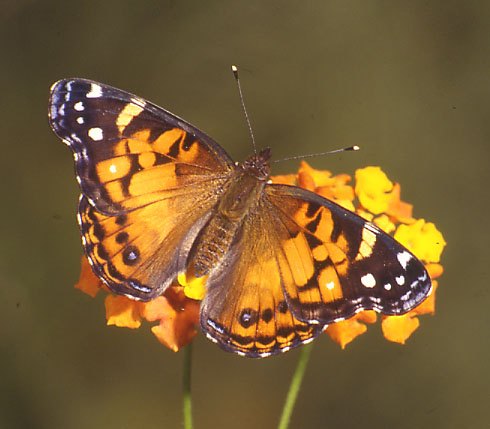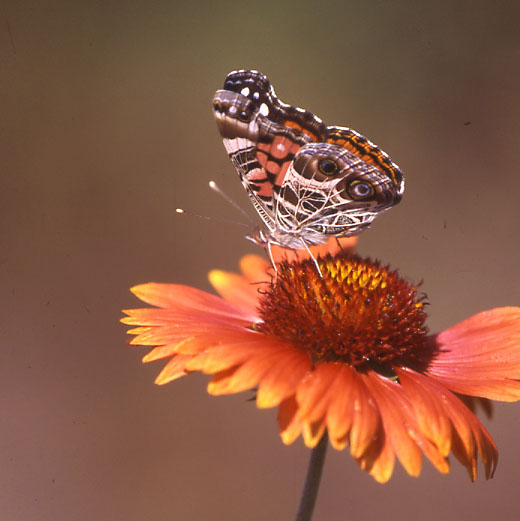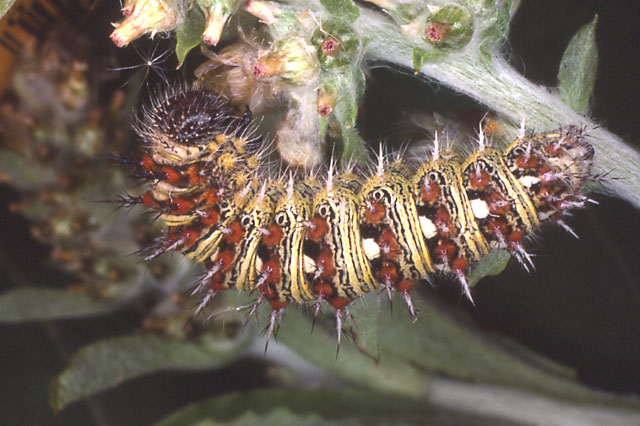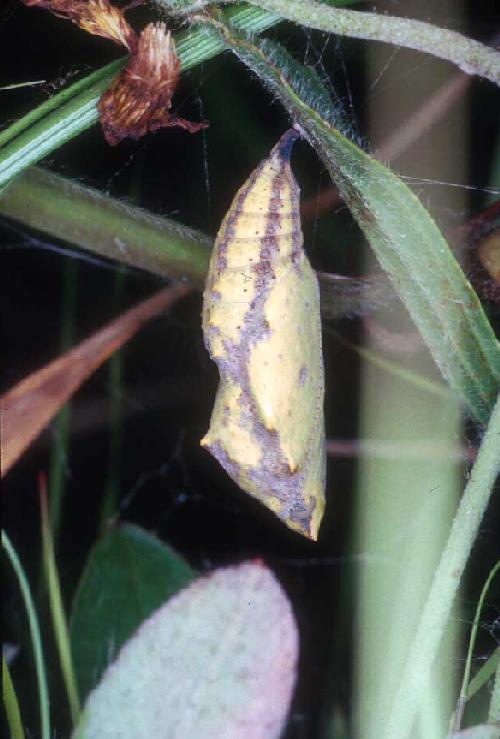Vanessa virginiensis
va-NES-uhmm
vir-gin-ee-EN-sis
(Drury, 1773) Nymphalis cardui virginiensis

Vanessa virginiensis, Florida, courtesy of Leroy Simon.
Superfamily: Papilionoidea Latreille, [1802]
Family: Nymphalidae Rafinesque, 1815
Subfamily: Nymphalinae Rafinesque, 1815
Tribe: Nymphalini Rafinesque, 1815
Genus: Vanessa Fabricius, 1807 |
Website designed and maintained
by Bill Oehlke
Box 476, Montague
Prince Edward Island, Canada C0A 1R0
oehlkew@islandtelecom.com
|
Caterpillar hosts: Plants in the sunflower family: sweet everlasting (Gnaphalium obtusifolium), pearly everlasting (Anaphalis margaritacea), plantain-leaved pussy toes (Antennaria plantaginifolia), wormwood (Artemisia), ironweed (Vernonia), and burdock (Arctium).
Distribution:
The American Lady,
Vanessa virginiensis (wingspan: 1 3/4 - 2 5/8 inches
(4.5 - 6.7 cm)) flies in open places with low vegetation
including dunes, meadows, parks,
vacant lots, forest edges and home gardens. It is a resident of
the southern United States, Mexico, and Central America south to
Colombia. It migrates to and temporarily colonizes the northern
United States, southern Canada, the West Indies, and Europe.
Occasionally a late summer stray makes its way to Newfoundland and
Labrador.
Description:
The upperside has an uneven brown, yellow,
and orange pattern. The forewing has a black apical patch, and there
is a small white spot in the
orange field below the patch, and a white bar at the leading edge
of the forewing.
The winter form is smaller and paler; the summer form is larger with
brighter coloring.
This butterfly is easily distinguished from its close relative the
Painted Lady (Vanessa cardui) by the two large, distinctive
eyespots on the underside of the hindwing. The Painted Lady has a
series of four or five smaller eyespots instead of the two large
ones of the American lady, below.

Vanessa virginiensis on Indian blanket, Florida, courtesy of
Leroy Simon.
Flight time(s) and Adult Food Sources:
This species broods continuously where weather/climate permit.
There are three to four broods from May-November in cooler climates.
It is not known if adults can survive very
cold winters; the East may have to be recolonized each year by
southern migrants.
This common butterfly can be found in Texas throughout the season
feeding on lantana, purple coneflower, milkweed, button bush,
dogbane, aster, goldenrod, marigold, selfheal, vetch and
many others.
Eggs, Larvae, Pupae:
During the afternoon, males perch on hilltops or on low
vegetation if there are no hills. Females lay eggs singly on the
top of host plant leaves. Caterpillars are solitary, living and
feeding in a nest of leaves tied with silk. The caterpillars prefer
to feed on pussytoes (Antennaria)
and plantains.
In Texas, Dale Clark lists Cudweed
(Gnaphalium obtusifolium); Pearly Everlasting
(Anaphalis margaritacea); Hollyhock (Althes rosea);
Nettles (Urtica spp.)
In Newbury, Massachusetts, Sharon Stichter uses
Antennaria plantaginifolia
in her butterfly garden. Sharon reports, "The food plant for American
Ladies which is most abundant in the wild in northeastern
Massachusetts is pussytoes--Antennaria neglecta, I think,
although there may be other species around, such as
Antennaria rosea".

Vanessa virginiensis, Florida, larva courtesy of Leroy Simon.

Vanessa virginiensis, Virginia, pupa by
Tom Allen.
Adults hibernate under house shingles, fallen brush, anywhere
they can find shelter from freezing winds.
Use your browser "Back" button to return to the previous page.
Visit other websites maintained by Bill Oehlke:
+++LIVESTOCK AND SUPPLIES FOR SALE***
This site is designed and
maintained
by Bill Oehlke. You can reach Bill for questions
by clicking on his name (email) or by phone 902-838-3455,
or at Bill Oehlke,
Box 476, Montague, P.E.I., Canada C0A 1R0.
I offer two membership sites that far exceed the
coverage offered
on the sites listed above:
THE WORLD'S LARGEST SATURNIIDAE SITE and
CATERPILLARS TOO!



